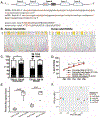Maturation of iPSC-derived cardiomyocytes in a heart-on-a-chip device enables modeling of dilated cardiomyopathy caused by R222Q-SCN5A mutation
- PMID: 37651922
- PMCID: PMC10942743
- DOI: 10.1016/j.biomaterials.2023.122255
Maturation of iPSC-derived cardiomyocytes in a heart-on-a-chip device enables modeling of dilated cardiomyopathy caused by R222Q-SCN5A mutation
Abstract
To better understand sodium channel (SCN5A)-related cardiomyopathies, we generated ventricular cardiomyocytes from induced pluripotent stem cells obtained from a dilated cardiomyopathy patient harbouring the R222Q mutation, which is only expressed in adult SCN5A isoforms. Because the adult SCN5A isoform was poorly expressed, without functional differences between R222Q and control in both embryoid bodies and cell sheet preparations (cultured for 29-35 days), we created heart-on-a-chip biowires which promote myocardial maturation. Indeed, biowires expressed primarily adult SCN5A with R222Q preparations displaying (arrhythmogenic) short action potentials, altered Na+ channel biophysical properties and lower contractility compared to corrected controls. Comprehensive RNA sequencing revealed differential gene regulation between R222Q and control biowires in cellular pathways related to sarcoplasmic reticulum and dystroglycan complex as well as biological processes related to calcium ion regulation and action potential. Additionally, R222Q biowires had marked reductions in actin expression accompanied by profound sarcoplasmic disarray, without differences in cell composition (fibroblast, endothelial cells, and cardiomyocytes) compared to corrected biowires. In conclusion, we demonstrate that in addition to altering cardiac electrophysiology and Na+ current, the R222Q mutation also causes profound sarcomere disruptions and mechanical destabilization. Possible mechanisms for these observations are discussed.
Keywords: Arrhythmias; Cardiac tissue; Dilated cardiomyopathy; Mutation; Nav1.5; SCN5A; Sodium channel; iPSC.
Copyright © 2023 Elsevier Ltd. All rights reserved.
Conflict of interest statement
Declaration of competing interest The authors declare the following financial interests/personal relationships which may be considered as potential competing interests: Peter H. Backx reports financial support was provided by Canadian Institutes for Health Research. Peter H. Backx reports financial support was provided by Peter Munk Cardiac Centre Innovation Committee Award. Kumaraswamy Nanthakumar reports financial support was provided by Heart and Stroke Foundation of Ontario. Brian J. Cox reports financial support was provided by Canadian Institutes for Health Research. Milica Radisic reports financial support was provided by Canadian Institutes for Health Research. Milica Radisic reports financial support was provided by National Institutes of Health. Yimu Zhao reports financial support was provided by Canadian Institutes for Health Research. Milica Radisic reports financial support and equipment, drugs, or supplies were provided by Canada Foundation for Innovation and the Ontario Research Fund. Milica Radisic is an inventor on a patent covering biowire heart-on-a-chip technology which is licensed to Valo Health. She receives royalties from Valo Health. Yimu Zhao is an inventor on a patent covering biowire heart-on-a-chip technology which is licensed to Valo Health. She receives royalties from Valo Health.
Figures








References
-
- Delicce AV & Makaryus AN in StatPearls (2020).
-
- McNair WP et al. SCN5A mutation associated with dilated cardiomyopathy, conduction disorder, and arrhythmia. Circulation 110, 2163–2167 (2004). 10.1161/01.CIR.0000144458.58660.BB - DOI - PubMed
Publication types
MeSH terms
Substances
Grants and funding
LinkOut - more resources
Full Text Sources
Miscellaneous

